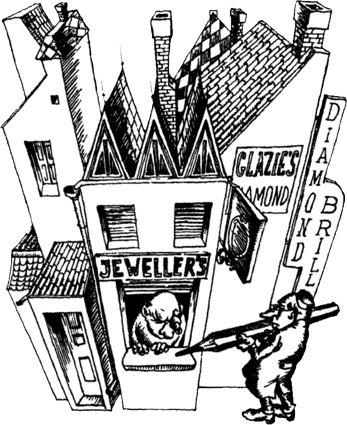107Stories About ChemistryINDEX |
73.
Diamond Again
Diamond is not the most important exhibit in our chemical museum. It is too simple to be unique. Its specific carbon skeleton surprises no one today. Back in the seventeenth century chemists burned diamond crystals in the sun�s rays using an ordinary magnifying glass. Chemists have long had something else on their minds, namely, how to transform graphite into diamond. Both of these are carbon, and all that had to be done was to find a way of rearranging the graphite carbon framework into that of diamond, and the hardest material in existence would thus be made from one of the softest, with nothing removed and nothing added. A way was finally found. It is a very amusing story and we shall tell it in its place. For the time being we shall remark only that what was needed to prepare artificial diamond was tremendous pressures.  And so, the hero of this story will be pressure. And not an ordinary pressure of a mere one, two or ten atmospheres, but superhigh pressures, when each square centimetre of surface area supports tens and hundreds of thousands of kilograms. Thus, superhigh pressures make it possible to obtain hitherto unknown substances. The alchemists knew two varieties of phosphorus, white and red. Now there is a third variety, black phosphorus. The heaviest, the densest, it is as good a conductor of electricity as many metals. Phosphorus, a typical nonmetal, was converted by superhigh pressures into an almost metallic substance, and a stable one at that. The example of phosphorus was followed by arsenic, and then by some other nonmetals. And each time the scientist observed striking alterations in properties. The heavy arm of superhigh pressure altered these properties before their very eyes. From the standpoint of physics nothing extraordinary had happened. Simply the superhigh pressure had rearranged the crystal structure of the elements and their compounds, making them more metallic. Thus appeared the purely physical term �pressure metallization.� ...Astronauts have already visited the Moon. Mars and Venus are now in the order of the day. Then will come the turn of other more distant and still more mysterious worlds. Men will time and again encounter the unusual, the unexpected, the unknown. But just now we are interested in a particular question. Are the chemical elements the same every where? Does the might of the Periodic Law and Mendeleyev�s Table extend to all cosmic bodies without exception? Or does the ingenious creation of the Russian scientist apply only on Earth? We hope we are not annoying the reader with our endless question marks. But really, it is much easier to ask questions than to answer them. Philosophers are of a definite opinion. They believe that the Periodic Law and the Periodic System are the same throughout the entire universe. That is where they are universal. They are the same, but with one essential reservation: only where ambient conditions do not differ too much from terrestrial conditions, where the temperature and the pressure are not multidigit numbers. And that is where they are limited. |





